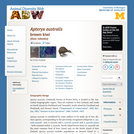
Apteryx australis: Information
- Subject:
- Life Science
- Zoology
- Material Type:
- Reading
- Provider:
- University of Michigan Museum of Zoology
- Provider Set:
- Animal Diversity Web
- Author:
- Kari Tervo (author), University of Michigan
- Date Added:
- 03/07/2005

Apteryx australis: Information
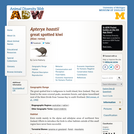
Apteryx haastii: Information

Apteryx owenii: Information
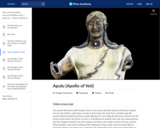
Apulu (Apollo of Veii), from the roof of the Portonaccio temple, Italy, c. 510-500 B.C.E., painted terracotta, 5 feet, 11 inches high (Museo Nazionale di Villa Giulia, Rome). Speakers: Dr Steven Zucker and Dr. Beth Harris.
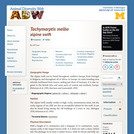
Apus melba: Information
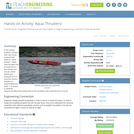
In this activity, students construct their own rocket-powered boat called an "aqua-thruster." These aqua-thrusters will be made from a film canister and will use carbon dioxide gas produced from a chemical reaction between an antacid tablet and water to propel it. Students observe the effect that surface area of this simulated solid rocket fuel has on thrust.
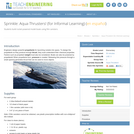
Students build rocket-powered model boats using film canisters.
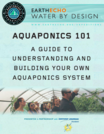
In this curricular guide, middle school students learn about an alternative farming technique that addresses water use in agricultural farming, the environmental impacts of fish farms, and urban development and population growth. This guide promotes 21st-century skills by engaging students in the history of aquaponics through various texts; improving their communication skills by explaining how an aquaponics system works; and engineering your own classroom aquaponics unit through an interactive design challenge!
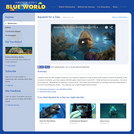
In this video Jonathan visits the New England Aquarium as a volunteer aquarist for a day to learn what it takes to care for thousands of fish in dozens of exhibits, up to the massive 200,000 gallon Giant Ocean Tank (GOT). What he finds is an eye openerŰÓitŰŞs not all fun and games. Maintaining an aquarium is serious work. But it does have its benefits, as Jonathan discovers while diving in the GOT and feeding the sharks. This segment won a New England Emmy Award! Please see the accompanying study guide for educational objectives and discussion points.
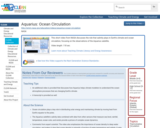
This short video from NASA discusses the role that salinity plays in Earth's climate and ocean circulation, focusing on the observations of the Aquarius satellite.

This course details the quantitative treatment of chemical processes in aquatic systems such as lakes, oceans, rivers, estuaries, groundwaters, and wastewaters. It includes a brief review of chemical thermodynamics that is followed by discussion of acid-base, precipitation-dissolution, coordination, and reduction-oxidation reactions. Emphasis is on equilibrium calculations as a tool for understanding the variables that govern the chemical composition of aquatic systems and the fate of inorganic pollutants.
This course is offered through The MIT/WHOI Joint Program. The MIT/WHOI Joint Program is one of the premier marine science graduate programs in the world. It draws on the complementary strengths and approaches of two great institutions: the Massachusetts Institute of Technology (MIT) and the Woods Hole Oceanographic Institution (WHOI).

Nas últimas décadas percebeu-se uma ampla cobertura por parte da mídia dos assuntos relacionados ao
aquecimento global. Porém, apesar da grande veiculação de matérias a respeito do assunto, inúmeros estudos em vários países apontam que os alunos de diversos níveis de ensino e professores têm uma compreensão limitada sobre a natureza e as consequências do aquecimento global. Por outro lado, estudos também apontam uma deficiência no ensino e no aprendizado sobre a fotossíntese, uma reação bioquímica bastante complexa de extrema importância para a manutenção da vida em nosso planeta, que está diretamente relacionada ao sequestro de carbono e consequentemente a mitigação do aquecimento global.
Nesse contexto, o viveiro de mudas educador da Escola Bosque, localizado na Ilha de Caratateua, distrito de
Outeiro na cidade de Belém, cidade que segundo o IBGE tem o pior índice de arborização comparada a outras
cidades brasileiras, torna-se um espaço privilegiado para trabalhar uma sequência didática sobre fotossíntese,
sequestro de carbono e mitigação do aquecimento global, apoiada na habilidade de ciências (EF07CI13) da
base nacional curricular comum.
A sequência didática estrutura-se em cinco módulos, iniciando com a problematização no módulo 1;
entendendo os fenômenos no módulo 2; o módulo 3 é destinado aos experimentos no viveiro educador; o
módulo 4 trata da montagem de mapas conceituais e da avaliação; a forma de socialização é tratada no módulo 5, ultimo módulo da sequência didática.

This resource is a video abstract of a research paper created by Research Square on behalf of its authors. It provides a synopsis that's easy to understand, and can be used to introduce the topics it covers to students, researchers, and the general public. The video's transcript is also provided in full, with a portion provided below for preview:
"Over the past decade, a variety of new drugs and surgical techniques have been developed to lower intraocular pressure and treat glaucoma. This trend has reinvigorated interest in understanding how and where aqueous humour outflow occurs. Three main pathways are currently known: trabecular, or **_conventional_**, outflow; uveoscleral, or **_unconventional_**, outflow; and subconjunctival outflow. Current methods for imaging these pathways are at varying stages of development, with conventional outflow imaging being the most advanced. Nevertheless, each route possesses a unique biology that can be leveraged in the quest for more knowledge about aqueous humour outflow. Conventional outflow accounts for approximately 90% of aqueous humour flow under physiologic conditions. Here, imaging methods have focused on capturing structural or flow-based features. Optical coherence tomography has enabled researchers to assess ocular tissue in live human subjects..."
The rest of the transcript, along with a link to the research itself, is available on the resource itself.

Well Field Practice: aquifer characterization through conducting and interpreting of aquifer pump tests.
(Note: this resource was added to OER Commons as part of a batch upload of over 2,200 records. If you notice an issue with the quality of the metadata, please let us know by using the 'report' button and we will flag it for consideration.)

The goal of this experiment is to measure the specific storage Ss of a balloon, which simulates aquifer elasticity. The experiment is designed to give observational meaning to the variable, increment of fluid content, and the influence of the state of stress on the specific storage. Increment of fluid content is the poroelastic variable defined as the amount of water added to storage per unit bulk volume. It is analogous to quantity of heat added to a unit volume of a material. Specific storage can then be expressed rigorously as the ratio of increment of fluid content divided by the change in head with specified external stress or strain conditions on the REV.
(Note: this resource was added to OER Commons as part of a batch upload of over 2,200 records. If you notice an issue with the quality of the metadata, please let us know by using the 'report' button and we will flag it for consideration.)
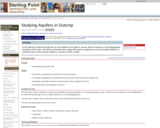
Students describe the hydrogeologic properties of different sedimentary and volcanic rocks.
(Note: this resource was added to OER Commons as part of a batch upload of over 2,200 records. If you notice an issue with the quality of the metadata, please let us know by using the 'report' button and we will flag it for consideration.)

Aquila chrysaetos: Information
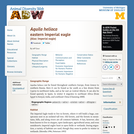
Aquila heliaca: Information

Ara Pacis Augustae (Altar of Augustan Peace), 13-9 B.C.E.Speakers: Dr. Beth Harris & Dr. Steven Zucker. Created by Beth Harris and Steven Zucker.

Ara Pacis Augustae (Altar of Augustan Peace), 13-9 B.C.E.Speakers: Dr. Beth Harris & Dr. Steven Zucker. Created by Beth Harris and Steven Zucker.